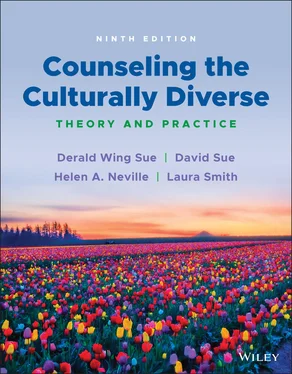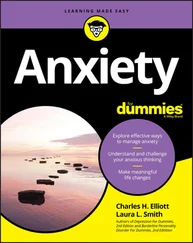Multiple studies that look at racial microaggressions in the lived experience of African Americans find that the cumulative effect of these events is feelings of self‐doubt, frustration, isolation, powerlessness, and invisibility (Skinner‐Dorkenoo, Sarmal, Andre, & Rogheer, 2021). In a two‐week daily diary study of Asian American college students’ experiences of microaggressions, it was found that 78% experienced at least one microaggression, and the reporting of such events predicted higher negative affect and more somatic symptoms (Ong, Burrow, Fuller‐Rowell, Ja, & Sue, 2013). This supports earlier qualitative work that reported Asian Americans feeling belittled, angry, invalidated, invisible, and trapped by their experiences of racial microaggressions (Sue, Bucceri, et al., 2007). Multiple studies suggest that Latinx and Chicano/a students feel marginalized and frustrated by microaggressive experiences in educational settings (Huber & Cueva, 2012; Nadal, Mazzula, Rivera, & Fujii‐Doe, 2014; Ramirez, 2014).
Investigations link the experience of microaggressions on college campuses with serious behavioral and psychological consequences. For example, college students of color who experienced greater numbers of microaggressions were at increased risk for higher anxiety and binge drinking (Blume, Lovato, Thyken, & Denny, 2012). Other studies link the experience of microaggressions with low self‐esteem, depression, fatigue, pain, and lower energy levels (Nadal, Wong, Griffin, Davidoff, & Sriken, 2014; Nadal et al., 2017; Wong‐Padoongpat, Zane, Okazaki, & Saw, 2017). Specifically, microaggressions experienced in educational and workplace settings were found to be especially harmful to participants’ self‐esteem (Nadal, Wong, et al., 2014). Likewise, homonegative microaggressions were associated with lower self‐esteem, negative feelings about one's sexual orientation identity, and obstacles to developing one's sexual identity (Wright & Wegner, 2012). A higher number of homonegative microaggressions experienced has also been linked to a high level of post‐traumatic stress disorder (PTSD) symptoms (Robinson & Rubin, 2016).
DILEMMA 4: THE CATCH‐22 OF RESPONDING TO MICROAGGRESSIONS
When a microaggression occurs, the recipient is often placed in an unenviable position of having to decide what to do. Numerous questions are likely to go through their mind: Did that really happen? If it did, how can I possibly prove it. How should I respond? Will it do any good if I bring it to the attention of the perpetrator? If I do, will it affect my relationship with the perpetrator and other onlookers? Many well‐intentioned perpetrators are unaware of the exhausting nature of these internal questions, as they sap the spiritual and psychic energy of victims. For Jaylen, dealing with microaggressions is emotionally draining and toll may be feelings of hopelessness, futility, and depression.
In essence, the Catch‐22 experienced by targets can be stated, “You are damned if you do and damned if you don't.” For targets, choosing to respond to microaggressions may have detrimental consequences. The person may be labeled a “trouble‐maker,” isolated, and in the case of Jaylen, be seen as the “angry Black man,” overly sensitive and even paranoid. For Melanie to confront the senior faculty member may lead to punitive actions, not being promoted and tenured in future decisions. On the other hand, choosing not to respond may result in self‐flagellation, internal rumination, disappointment in the self, self‐blame, feelings of disempowerment and self‐betrayal, and low self‐esteem (Sue, Alsaidi, Awad, Glaeser, Calle, & Mendez, 2019).
Although microaggressions operate under similar social psychological principles, the themes directed toward different groups vary: (a) Asian American/Pacific Islanders and Latinx Americans experience themes of perpetual alien in their own country and invisibility, (b) African Americans experience criminality and dangerousness, (c) Indigenous people experience criminality and inferiority of their culture, (d) women experience sexual objectification, and (e) LGBTQ experience themes of sinfulness and disgust.
Sources: Sue and Spanierman (2020); Jones and Galliher (2014).
Clients of color tend to prematurely terminate counseling and therapy at a rate much higher than their White counterparts. We submit that racial microaggressions may lie at the core of the problem. For example, one study found that more than half of racial‐ and ethnic‐minority clients at a college counseling center reported experiencing a microaggression from their therapist (Owen, Tao, Imel, Wampold, & Rodolfa, 2014), and other studies report between 43% and 81% of clients experiencing at least one microaggression in therapy (Hook et al., 2016; Owen et al., 2012, 2015). The most commonly experienced microaggressions involved therapists’ subtle expression of cultural stereotypes and avoidance of or minimization of cultural issues (Hook et al., 2016). A similar study of LGBTQ clients revealed, “clients were left feeling doubtful about the effectiveness of therapy, the therapists’ abilities, and the therapists’ investment in the therapeutic process when therapists minimized their sexual reality” (Shelton & Delgado‐Romero, 2011, p. 217).
There is growing evidence to suggest that racial, gender, and sexual orientation microaggressions have a detrimental effect on the therapeutic alliance for clients of color (Owen et al., 2014), women (Owen, Tao, & Rodolfa, 2010), and LGBTQ individuals (Shelton & Delgado‐Romero, 2011, 2013). Specifically, “microaggressions can be thought of as a special case of ruptures in therapy, wherein experiences of discrimination and oppression from the larger society are recapitulated, which places the therapeutic relationship under duress and strain” (Owen et al., 2014, p. 287). Qualitative work with LGBTQ clients supports this finding, where the therapeutic alliance has been diminished by the presence of sexual orientation microaggressions: “affective consequences of sexual orientation microaggressions included clients feeling uncomfortable, confused, powerless, invisible, rejected, and forced or manipulated to comply with treatment” (Shelton & Delgado‐Romero, 2013, p. 66).
One study found that microaggressions that went unaddressed by therapists were associated with a weaker working alliance compared to situations with (a) no microaggression or (b) a resolved microaggression (Owen et al., 2015). Although studies on microaggressions in therapy suggest that they are frequent and harmful, evidence also shows that when microaggressions are acknowledged and addressed, the therapeutic alliance can be restored with positive clinical outcomes (Owen et al., 2014; Owen, Tao, & Drinane, 2019). Therefore, it is paramount that helping professionals examine their own biases and beliefs and remain aware of how they may unintentionally communicate these when working with clients who are culturally diverse.
Although therapy provides an ideal opportunity for exploring microaggressions both within the therapeutic dyad and in presenting concerns, many therapists are unsure how to approach such conversations. The multicultural orientation (MCO) framework (Owen, 2013) can be used to help therapists engage in a discourse on race, culture, racism, and microaggressions. This framework includes three pillars: (a) cultural humility, (b) cultural opportunities, and (c) cultural comfort. These pillars involve therapists being (a) aware of their own cultural values and those of others, (b) curious about others’ cultural identities and values, and (c) at ease and comfortable with discussions that involve race, racism, and culture. Studies suggest that these variables are associated with more positive therapeutic outcomes. Specifically, counselors who score higher on cultural humility (a) are less likely to microaggress and (b) have more positive therapy outcomes (Hook et al., 2016; Owen et al., 2014, 2017). Table 4.2 provides several more therapy‐specific examples of microaggressions, using the same organizing themes presented in Table 4.1. We ask that you study these themes and ask if you have ever engaged in these or similar actions. If so, how can you prevent your own personal microaggressions from impairing the therapy process?
Читать дальше












